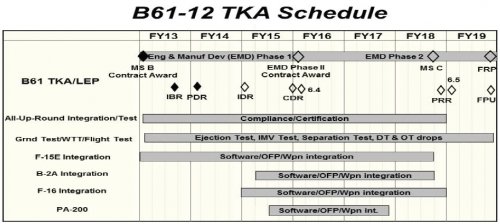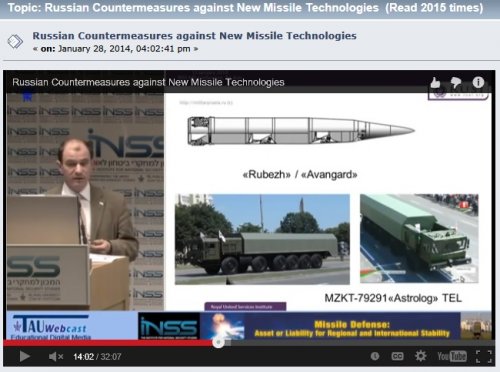- Joined
- 21 April 2009
- Messages
- 13,713
- Reaction score
- 7,586
Inside the Air Force - 02/28/2014
W80, W84 being considered
Air Force And NNSA To Select Nuclear Cruise Missile Warhead In Mid-2015
Posted: Feb. 27, 2014
The National Nuclear Security Administration will begin its formal study this July of the two potential warheads that could go on a new nuclear cruise missile, according to an Air Force official. A selection between them would then be expected about a year later.
The two warheads being considered that would give the Long-Range Standoff Missile (LRSO) its nuclear capability are the W80, which is fielded on today's Air-Launched Cruise Missile, or the W84 -- a retired warhead formerly fielded on the Ground-Launched Cruise Missile. Either one would require a life-extension and improvement program to provide the capability the Pentagon is looking for.
In a Feb. 21 interview at the Pentagon, Air Force Lt. Col. Karson Sandman and Lt. Col. Benjamin Travers discussed the status of the LRSO program, which requires both the development of a new missile and the rehabilitation of an existing nuclear warhead. Sandman is the chief of the service's stockpile science and technology branch, responsible for monitoring warhead activities, while Travers is the weapons and platforms branch chief; both of those branches fall within the capabilities division of the Air Force's strategic deterrence and nuclear integration directorate.
Sandman, who works closely with the National Nuclear Security Administration that will perform the planned warhead development work in the near future, said the NNSA will truly begin comparing the two potential warheads in July. That analysis phase is referred to as the "6.1" stage of the administration's acquisition cycle.
A selection between the W80 and W84 would then come around the summer of 2015, he said.
"Activities involved in the 6.1 phase will include an analysis of each of the two warhead candidates against military requirements ranging from quantities to desired technical and surety features," Sandman wrote in a follow-up Feb. 26 email. "One of the first priorities will be to identify the scope of the study and balance that against NNSA and Air Force budgets. The Air Force has requested that a warhead selection be jointly agreed to by the end of the 6.1 phase (approximately one year from inception)."
During the interview, Sandman said the Air Force and NNSA work under a general rule of designing life-extension programs for a period of 10 years, although the actual performance time may vary depending on requirements and funding. That schedule dictates the process should begin shortly, as the Air Force picks up the pace of its LRSO development in fiscal year 2015 as well.
Travers said the LRSO program staff is working on a variety of "pre-milestone A" activities, with a milestone A decision that would clear the program to award one or several technology development contracts expected in the summer. He said the Air Force has not yet decided how much competition is appropriate for LRSO development.
"Do you do competitive prototyping? Do you do prototyping only at the component level? Those questions are being asked and vetted and answered now," Travers said.
As Inside the Air Force has previously reported, four of the defense industry's most prominent companies -- Lockheed Martin, Boeing, Northrop Grumman and Raytheon -- are performing LRSO trade studies on a variety of topics. Travers said those studies do not need to be complete ahead of the milestone A review.
The Air Force completed an LRSO analysis of alternatives in 2013.
Sandman noted that the NNSA's somewhat limited warhead production capabilities and its budget -- much more restricted than the Pentagon's -- sometimes cause nuclear programs to progress more slowly than would otherwise occur. That may impact the LRSO program, as NNSA has a number of ongoing warhead life-extensions in the works today.
"They have their labs and then they have their production facilities, and if their production facilities only have a certain capacity and they're doing a full [life-extension program], then they can only fit some discreet amount of work into that schedule," he said. "So then we have to time other events and other program upgrades into that overall schedule."
The service does have some flexibility in its schedule, as the current AGM-86 Air-Launched Cruise Missile is set to remain in service until 2030. But the desire to field a new missile simultaneously with a new nuclear-capable bomber dictates that LRSO be ready by the mid-2020s, the Air Force's stated time line for fielding of the developmental Long-Range Strike Bomber. -- Gabe Starosta
W80, W84 being considered
Air Force And NNSA To Select Nuclear Cruise Missile Warhead In Mid-2015
Posted: Feb. 27, 2014
The National Nuclear Security Administration will begin its formal study this July of the two potential warheads that could go on a new nuclear cruise missile, according to an Air Force official. A selection between them would then be expected about a year later.
The two warheads being considered that would give the Long-Range Standoff Missile (LRSO) its nuclear capability are the W80, which is fielded on today's Air-Launched Cruise Missile, or the W84 -- a retired warhead formerly fielded on the Ground-Launched Cruise Missile. Either one would require a life-extension and improvement program to provide the capability the Pentagon is looking for.
In a Feb. 21 interview at the Pentagon, Air Force Lt. Col. Karson Sandman and Lt. Col. Benjamin Travers discussed the status of the LRSO program, which requires both the development of a new missile and the rehabilitation of an existing nuclear warhead. Sandman is the chief of the service's stockpile science and technology branch, responsible for monitoring warhead activities, while Travers is the weapons and platforms branch chief; both of those branches fall within the capabilities division of the Air Force's strategic deterrence and nuclear integration directorate.
Sandman, who works closely with the National Nuclear Security Administration that will perform the planned warhead development work in the near future, said the NNSA will truly begin comparing the two potential warheads in July. That analysis phase is referred to as the "6.1" stage of the administration's acquisition cycle.
A selection between the W80 and W84 would then come around the summer of 2015, he said.
"Activities involved in the 6.1 phase will include an analysis of each of the two warhead candidates against military requirements ranging from quantities to desired technical and surety features," Sandman wrote in a follow-up Feb. 26 email. "One of the first priorities will be to identify the scope of the study and balance that against NNSA and Air Force budgets. The Air Force has requested that a warhead selection be jointly agreed to by the end of the 6.1 phase (approximately one year from inception)."
During the interview, Sandman said the Air Force and NNSA work under a general rule of designing life-extension programs for a period of 10 years, although the actual performance time may vary depending on requirements and funding. That schedule dictates the process should begin shortly, as the Air Force picks up the pace of its LRSO development in fiscal year 2015 as well.
Travers said the LRSO program staff is working on a variety of "pre-milestone A" activities, with a milestone A decision that would clear the program to award one or several technology development contracts expected in the summer. He said the Air Force has not yet decided how much competition is appropriate for LRSO development.
"Do you do competitive prototyping? Do you do prototyping only at the component level? Those questions are being asked and vetted and answered now," Travers said.
As Inside the Air Force has previously reported, four of the defense industry's most prominent companies -- Lockheed Martin, Boeing, Northrop Grumman and Raytheon -- are performing LRSO trade studies on a variety of topics. Travers said those studies do not need to be complete ahead of the milestone A review.
The Air Force completed an LRSO analysis of alternatives in 2013.
Sandman noted that the NNSA's somewhat limited warhead production capabilities and its budget -- much more restricted than the Pentagon's -- sometimes cause nuclear programs to progress more slowly than would otherwise occur. That may impact the LRSO program, as NNSA has a number of ongoing warhead life-extensions in the works today.
"They have their labs and then they have their production facilities, and if their production facilities only have a certain capacity and they're doing a full [life-extension program], then they can only fit some discreet amount of work into that schedule," he said. "So then we have to time other events and other program upgrades into that overall schedule."
The service does have some flexibility in its schedule, as the current AGM-86 Air-Launched Cruise Missile is set to remain in service until 2030. But the desire to field a new missile simultaneously with a new nuclear-capable bomber dictates that LRSO be ready by the mid-2020s, the Air Force's stated time line for fielding of the developmental Long-Range Strike Bomber. -- Gabe Starosta


